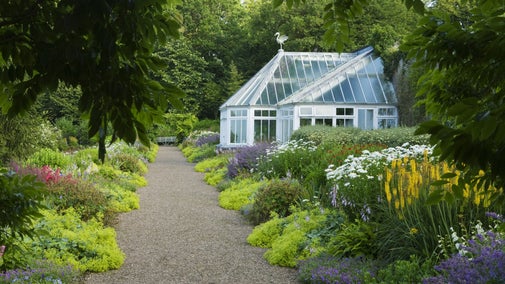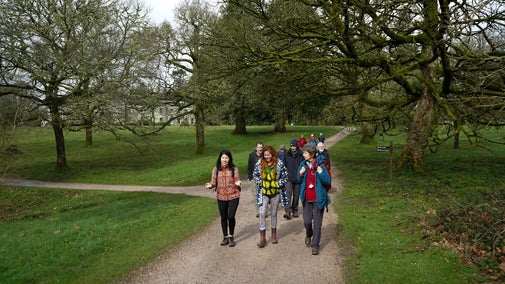
Discover more at Arlington Court and the National Trust Carriage Museum
Find out when Arlington Court and the National Trust Carriage Museum is open, how to get here, the things to see and do and more.

The 30 acres of grounds that surround the house at Arlington are set in picturesque style. The planting was carefully designed to give views and vistas mainly from the house, but also from carriage drives and footpaths. Discover more about how the grounds changed and developed over the years to the garden you see today.
The picturesque style was very fashionable in the late eighteenth and early nineteenth century; hence the Chichester family choosing to have their grounds landscaped this way. Features and follies were often used to create interest for visitors to discover on trips through the gardens.
Contrasts between areas of light and shade, formal and informal, natural and unnatural were all important within a picturesque garden. The easiest way to think of it is as if stepping into a picture of a wonderful view.
During the remodelling of the medieval manor house south of the church, in 1790, Colonel John Chichester redesigned the old Tudor gardens into picturesque parkland.
When the current house was built in the 1820s, Colonel Chichester continued to develop the area around his new house in the picturesque style. This involved removing hedgerows and cultivated land and moving towards more clusters of trees and shrubs with grassland between.

Colonel John’s son, Sir John Chichester, had grander plans for the gardens and estate. He rebuilt some of the gate houses and Home Farm in a more gothic style to create interest when visitors arrived. From the gate houses, visitors would have travelled to the house on long winding carriage drives with a number of views and points of interest en route.
One drive would have crossed the lake on a suspension bridge, which was left unfinished when he died in 1851; the bridge piers are still visible to anyone venturing to the old lake.
The estate passed to his son Sir Bruce Chichester, who introduced monkey puzzle trees to the grounds and garden as a wedding present to his wife, Lady Rosalie.
Miss Rosalie Chichester, daughter of Sir Bruce and Lady Rosalie, took control of the estate in 1881 and seems to have maintained the grounds and gardens as her father left them until the 1920s when nature was allowed to take control.
This was in part caused by Rosalie’s love of wildlife, but financial and social circumstances may have contributed. After the Second World War, outer areas of the pleasure grounds not regularly visited by Miss Chichester would have been completely left to grow wild. In 1949 she died, and the estate passed to the National Trust.

In the 1970s John Sales, then Chief Gardens Adviser for the National Trust, advised Arlington to adopt a more historically informed approach to the gardens and grounds.
The Victorian garden was developed further with a long border introduced on the top tier of the gardens. A ha-ha was created on the south and west edge of the pleasure grounds to replace a fence which had prevented deer and livestock entering the park.
The 21st century has seen further changes. Phytopthora was found on a number of large rhododendrons within the grounds and all affected plants needed to be removed.
Today the gardeners work with nature to create natural beauty, using native plants where possible. Introduction of spring and autumn interest plants is one way the gardeners are replacing the lost colour from the rhododendrons.

Find out when Arlington Court and the National Trust Carriage Museum is open, how to get here, the things to see and do and more.
The house at Arlington Court is the work of generations of the Chichester family. Discover how each heir left their mark on the building you see today.

Find out how to have a dog-friendly visit to Arlington, when to keep them on a lead and what facilities are available. Arlington Court is a three pawprint rated place.

From the ever-changing flowers of the formal Victorian Garden to picture-perfect pleasure grounds, the garden at Arlington Court is beautiful whatever the weather. Step into the hidden walled kitchen garden for variety through the seasons.

Discover the Arlington Estate with 2,600 acres to explore and over 25 miles of paths, enjoy walks, scenic runs and exciting bike rides.

Take a closer look at some of the items assembled at Arlington Court by the Chichester family through 11 generations of ownership.

Learn about people from the past, discover remarkable works of art and brush up on your knowledge of architecture and gardens.

Explore the objects and works of art we care for at Arlington Court on the National Trust Collections website.
